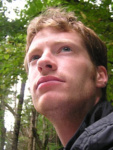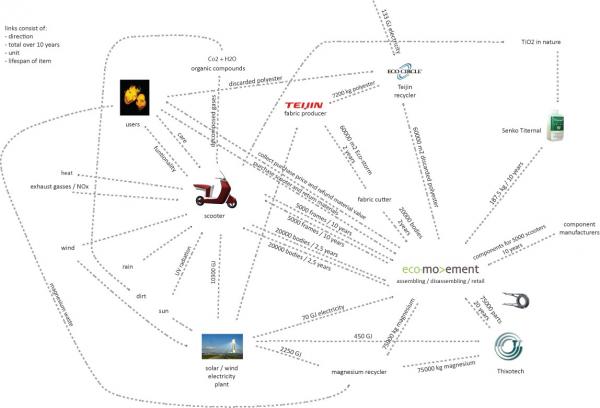An Interview with a Bio-Inspired Designer (Ernst-Jan Mul)
 Norbert Hoeller caught up (virtually) with Ernst-Jan Mul in a Barcelona café. Ernst-Jan had just participated in a brain-storming session organized by Fco. Javier of Aleen on the bio-inspired development of a deep-sea robot. Although many people are looking to nature for design ideas, Ernst-Jan is one of the few who has tried to build a career around practicing bio-inspired design. He has been active in promoting the field of biomimicry by developing new tools, educating students, training companies, applying biomimetic strategies in design projects and through research.
Norbert Hoeller caught up (virtually) with Ernst-Jan Mul in a Barcelona café. Ernst-Jan had just participated in a brain-storming session organized by Fco. Javier of Aleen on the bio-inspired development of a deep-sea robot. Although many people are looking to nature for design ideas, Ernst-Jan is one of the few who has tried to build a career around practicing bio-inspired design. He has been active in promoting the field of biomimicry by developing new tools, educating students, training companies, applying biomimetic strategies in design projects and through research.
Norbert: How did you get involved with biomimicry?
Ernst-Jan Mul: I have always been intrigued by the idea that products could be like organisms: growing, adapting, learning and being an integral part of their own sustainable ecosystem. I selected biomimicry as part of my Masters program in Integrated Product Design at the Delft University of Technology, even though the faculty was not familiar with the concepts of biomimicry. My graduation project combined my interests in research, sustainability, biology and technology. I translated the sustainability paradigm of biomimicry into a structured design strategy using the design of an electric scooter as a practical application.
Norbert: Since graduating in 2009, where have you taken your interest in biomimicry?
Ernst-Jan Mul: I have been working as a freelance designer since January 2010 on a wide range of projects including rapid manufacturing, writing papers and several articles on Biomimicry, taking part in an international think tank as a biomimic, working together with the sustainable design agency Ideal&Co, and helping designers, architects and companies like TenCate to appreciate and implement sustainability in their design practices.
Norbert: How has biomimicry changed the way that you approach product design?
Ernst-Jan Mul: We need to switch from a mindset of reducing negative impacts to one where we make positive contributions to the environment. Biomimicry has helped me see product development as strongly shaped by the context, in the same way that the development of organisms is heavily shaped by their environment. To be successful, products need to be strongly connected to their environment, both the technical and the natural. To be sustainable, we need to be able to map, analyze and develop these connections.
Norbert: What tools have you found useful in your bio-inspired design activities?
Ernst-Jan Mul: I have used a wide range of analysis, synthesis and materialization tools including function analysis, the Life’s Principles, AskNature.org and Life Cycle Analysis. I was not able to find tools relating to the connectivity of products to the environment. I created an environment scan tool that analyzes the environment of a product throughout its lifecycle, considering energy forms, materials, organisms and organizations. The output of this tool feeds into a connection diagram, a visual representation of the key elements in the ecosystem of the product from the perspective of the product’s functionality. The goal of my design process is to increase the degree of connectivity as well as enhancing synergistic relationships. The visual nature of the tool lends itself to mapping, understanding and communicating complex situations.
Norbert: How do you see bio-inspired design relating to sustainability?
Ernst-Jan Mul: Although sustainability is one of my primary goals, additional research is required to prove that bio-inspired design can deliver more sustainable products. When we look to nature for solutions, we often use physical or engineering terms which may prevent us from fully appreciating how nature works. As in all complex systems, cause and effect relationships between what we see in nature, how we interpret what we see and what we design are rarely straightforward. I believe we can increase the likelihood of sustainable products by moving beyond mimicking individual organisms to creating human designs that live in the environment and bring value to that environment.
Norbert: How have you been able to influence other designers?
Ernst-Jan Mul: I have presented the connection diagram tool at a number of workshops as a way to generate ideas and help designers see how products can be a positive force in the environment. I tend to introduce bio-inspired design in an unobtrusive and pragmatic way so as to include designers who do not ‘get’ biomimicry.
Norbert: What are your future plans?
Ernst-Jan Mul: I would like to use the connection diagram to integrate information from meteorological and ecological databases to incorporate a deeper understanding of the "habitat" of products. We need comprehensive and integrated toolkits that incorporate not only our growing knowledge of nature but also new design paradigms and manufacturing techniques.
Norbert: Ernst-Jan, on behalf of the BID Community, thanks for taking the time to talk about your experiences as a bio-inspired designer!
Image Credits:
- On Air: © frank peters - Fotolia.com
- electric scooter: Mul, E-J. (retrieved 2011/03/05)
- connection diagram: Mul, E-J., (2009). Biomimicry in product design: exploring the possibilities

Ernst-Jan Mul graduated in 2009 with an MSc in Integrated Product Design from the Delft University of Technology. Combining his interest in research, sustainability, biology and technology, he translated the sustainability paradigm of biomimicry into a structured design strategy. He works as a freelance bio-inspired designer since January 2010.


